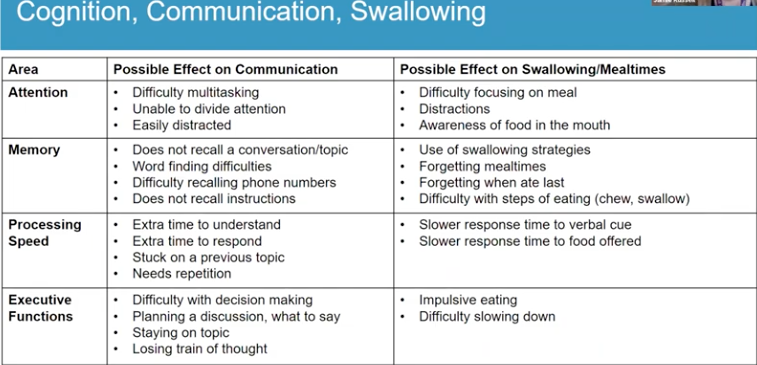

In September, the Parkinson Society British Columbia hosted a webinar on “language impairment” in Parkinson’s disease (PD) though the focus was on how those with PD and caregivers can cope with communication, swallowing, and cognition changes. The coping strategies were suggested by speech language pathologist Jamie Russell. We took notes during the webinar and shared them here.
Here are some examples of the strategies Jamie Russell suggested for communication:
Communication strategies for caregivers
- Reduce background noise
- Eye contact
- Hearing aids and glasses
- Make sure it’s a good time – time of day, energy, abilities
- Have conversation aids or visuals if needed
- Give context
- Simplify the message
Communication strategies for the person with PD
- Slow down
- Take a deep breath
- Exaggerate articulation
- Be louder
- Word finding strategies
- Confirm your communication partner understood
- Take a break
Many more suggestions are in my detailed notes below.
The webinar was recorded and is accessible on YouTube.
The Stanford Parkinson’s Community Outreach Program has several webpages with more information on topics raised in this webinar:
Regards,
Sheela Sakariya
“Language Impairment” – Webinar Notes
Webinar Host: Parkinson Society British Columbia
Webinar Date: September 21, 2021
Speaker: Jamie Russell, MScA, RSLP, SLP(C), speech language pathologist, Jim Pattison Outpatient Care and Surgery Centre, BC, Canada
Summary by: Sheela Sakariya, Stanford Parkinson’s Community Outreach
Parkinson’s Disease (PD)
- Progressive movement disorder
- Loss of dopamine – a key player
- Cardinal signs: tremor, stiffness, slowed movement
- Motor and non-motor symptoms
- Whole body disease
PD is more than what we can see! It’s also non-motor things we cannot see such as bowel movements, constipation, blood pressure, mood, etc. One interesting thing about PD is that the motor functions (tremor, slowness) work the same on our speech and swallow muscles as they do for the rest of your body.
Communication
- Speech: includes articulation (how we produce sounds), phonology (how we organize those sounds), motor speech (how we put together sounds into words)
- Voice and resonance: quality of voice and nasal sounds
- Fluency: stuttering
- Language: verbal expression (word finding, sentence forming) and comprehension (understanding)
- Written expression: spelling, simple list taking, writing essay
- Reading comprehension: decoding what you are reading, understanding what you read
- Cognitive communication: social communication (how we talk to others)
Swallowing
- Getting food/liquid in your mouth
- Keeping food/liquid in your mouth
- Moving food/liquid in your mouth
- Tongue movements and chewing
- Getting food/liquid to your esophagus
- Protecting your airway
- Clearing food/liquid from mouth/throat
Common communication changes due to PD
- Quieter volume or difficulty changing volume
- Imprecise articulation
- Breathy or hoarse voice
- Monotone speech
- Less melody (prosody) variation
- Change in rate of speech
- Difficulty initiating speech
- Dysfluency
- Decreased facial expression
- Word finding difficulty
- Sensory feedback impacted
Common swallowing changes due to PD
- Slow eating/drinking, increased meal times
- Pocketing food
- Trouble controlling food/drinks
- Slowed, less efficient chewing/moving food
- Difficulty starting a swallow
- Food feels stuck
- Coughing, throat clearing, or choking
- Drooling or excess saliva
- Difficulty swallowing pills
- Can be: recurring pneumonia, chest infection, weight loss, eliminating food from diet.
If a person is experiencing any of the signs or symptoms discussed above, please ask for a referral to your speech language pathologist (SLP) for assessment/treatment options.
Common cognitive changes due to PD
Mild cognitive impairment and dementia can occur in the PD population. Here are some areas of common cognitive changes: memory, attention, processing speed, executive functions, perception, and language. Cognitive changes impact speech and swallowing also.
Cognition can change for many underlying reasons:
- Acute changes (eg. infection)
- Stress, mood
- Aging
- Lack of sleep
- Hydration
- Hearing loss, vision changes
- Medication side effects
- Other diseases

Communication strategies for caregivers
- Reduce background noise
- Reduce distractions
- 1:1 vs group setting
- Good lighting
- Face each other
- Eye contact
- Hearing aids and glasses
- Make sure it’s a good time – time of day, energy, abilities
- Have conversation aids or visuals if needed
- Give context
- Simplify the message: shorter sentences, say it slowly and at normal volume, be direct but kind, yes/no or simple choices, proper names vs pronouns, break it down
- Say it in more than one way: include pictures, objects, environment; gestures; memory tools; write down keywords
- Support understanding: be patient; provide time to process and respond; confirm understanding; repeat the message; rephrase; summarize; refer to keywords; break down a loner message; hearing/vision
- Listen closely: be an active listener; use body language; eye gaze; intonation, context, word choice
- Be honest if you didn’t understand: ask for repetition or clarification
- Confirm
- Be open to and ENCOURAGE other ways of communicating: notepad, AAC, gesture, pointing, drawing
- Be patient, encouraging, respectful
Know when to take a break and don’t demand perfection!
Communication strategies for the person with PD
- Slow down
- Take a deep breath
- Exaggerate articulation
- Be louder
- Say it in less words
- Use other ways to communicate: writing, gesture, drawing, AAC
- Word finding strategies
- Confirm your communication partner understood
- Take a break
Swallowing and mealtimes strategies for caregivers
- Environment – calm, quiet
- Reduce distractions
- Don’t hurry
- Consider energy conservation
- Sit at eye level
- Visual or verbal cues
- Reduce bite/sip sizes
- Encourage cutlery down between bites
- Watch for swallow
- Check mouth for residue
- Support oral care (to reduce the risk of aspiration, pneumonia; brushing teeth)
- Staying upright for 30 minutes
- Monitor weight, intake, sign/symptoms of aspiration, pneumonia
- Incorporate wishes/choices
- Avoid force feeding
- Learn what to do in an emergency
- Pay attention to timing
Everyone is different – follow the recommendation of your SLP as they pertain to you.
Strategies for daily life
- Routine
- Daily routine – check it off; gets rid of uncertainty/anxiety about the day
- Calendar, planners, whiteboard, notebooks
- A place for everything, and everything in its place
- Laminated lists and checkboxes
- Habit stacking
- Support independence
- Reminders
- Create and keeps lists for common things: groceries, phone numbers
- Sticky notes or whiteboard markers
- Alarms, smartphones, watches, time timer
- Notebooks: daily dairy, for lists, by the phone
- Labels
- Color code
- Orientation station: an area in your home with information about the day, month, time, year. It can also include:
- Monthly calendar
- A whiteboard
- Important contacts
- Daily routine
- Digital clock
- Photos of family/friends
- Launch pad: a designated place for everything you need when you leave the house
- Keys, purse, mask, mobility aid
- Emergency contact information
- Note reminders
- Memory books: put together a photo album that includes
- About me page (where I was born, job, family, accomplishments)
- Hobbies, interests
- Pictures of family/friends with names
- Emergency contact information
- Use as communication support or reminiscing
- Technology
- Alarms – on clocks or smart phones
- Voice activated technology (VAT) – Google Home, Alexa, Siri, etc.
- Set reminders on phones (calendar pop ups)
- Put appointments in phone calendars
- Use zoom or video to maintain social connections
- Stay active
- Physical exercise
- Cognitive exercise: puzzles, sudoku, word searches
- Linguistics exercise – using speech, voice (call friends, discuss current events, socialize, engage)
Question & Answer Session
Question: What are some word-finding strategies?
Answer: Some strategies include gestures, pointing to things in the environment to help find a word, talking around a word, coming up with a synonym or antonym can also help. If you are the caregiver, give them a cue to help them think about the word.
Question: My husband is in a care home; how do I get a referral for a SLP?
Answer: You can ask your GP for a referral to the SLP. Once a referral is put in, you can bring your husband to the SLP. Alternatively, you can also look at private speech therapy services and someone will be able to come out to the care home and help him.
Question: How do you clear your throat when you have difficulty swallowing food?
Answer: When you are swallowing liquid and it goes down the wrong way, and it’s touching the top of your voice box, it’s your body’s response to clear your throat. It’s your body’s natural response.